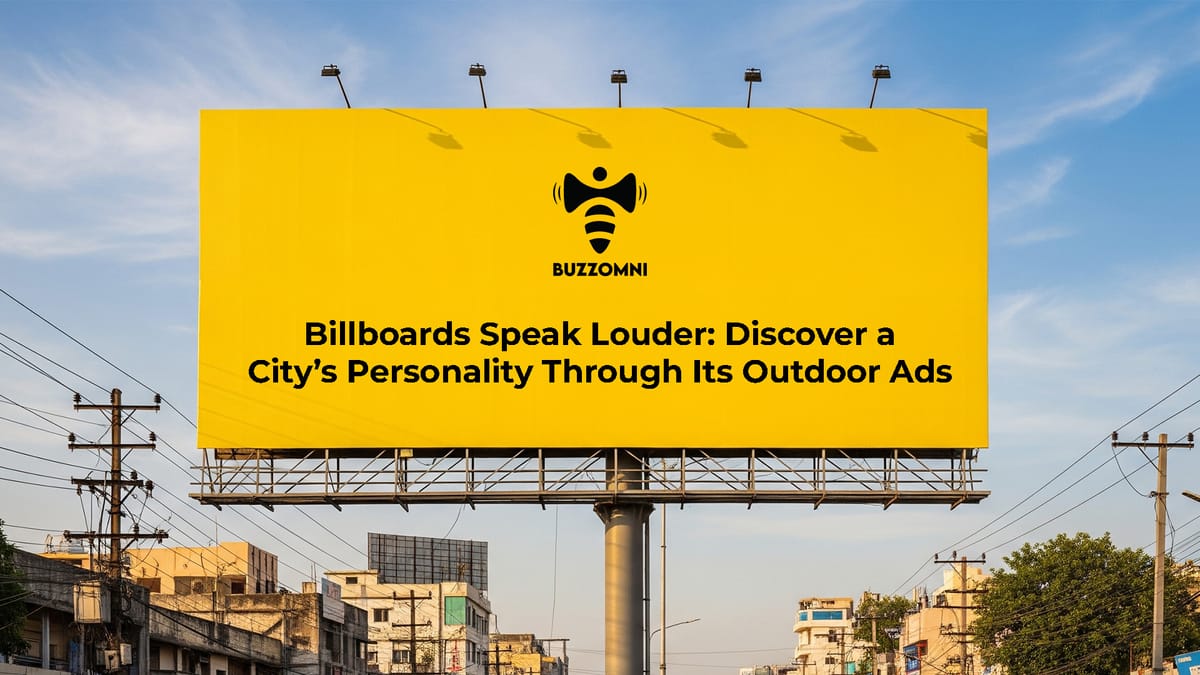Billboards as City Moodboards: What Outdoor Ads Reveal About a Place
Billboards are more than ads—they’re reflections of a city’s identity. From Times Square to Tokyo’s neon, outdoor ads reveal ambitions, culture, and trends, offering an unfiltered snapshot of urban life and what people aspire to.

Table of Contents
- Introduction
- The City’s Personality in Print
- Aspirations on Display
- The Local Meets the Global
- Reading Between the Ads
Introduction
Walk through any major city, and you’ll notice more than just its architecture, skyline, or street food carts. Looming above sidewalks and peeking between buildings are the billboards—massive canvases of persuasion. But if you look closer, you’ll see they’re not just selling shoes, sodas, or streaming services.
Billboards are city moodboards, silently reflecting what people value, aspire to, and how they see themselves. Platforms like BuzzOmni make this even more visible, aggregating these signals to show brands exactly what resonates with city dwellers in real time.
The City’s Personality in Print
Every city has a distinct vibe. New York hums with ambition and hustle. Los Angeles flexes creativity and glamour. Tokyo dazzles with futuristic neon. Mumbai buzzes with energy and resilience. Billboards capture these vibes in real time. A city plastered with luxury handbag ads reveals its appetite for status. Another covered with tech startup campaigns showcases innovation-driven culture. Wellness retreat posters? The local population is invested in balance and self-care.
Outdoor advertising is reactive. Brands don’t invest millions in ad space without tailoring messages to the city’s psyche. What you see on a billboard is often a mirror of what people are chasing—or what companies believe they’re missing.
Aspirations on Display
Take Times Square. Beyond the sensory overload, the ads there are aspirational: Broadway shows promise escape, designer brands promise elevation, gadgets promise connection. In essence, the billboards compress New York’s personality—ambitious, attention-seeking, always aiming higher.
Compare that to Berlin, where outdoor ads lean into edgy fashion, sustainability, or nightlife. The city’s counterculture and eco-conscious ethos bleed directly into its advertising.
Billboards don’t just highlight what’s popular—they hint at what’s next. Wellness campaigns spreading across U.S. cities aren’t just about selling gym memberships; they signal a cultural shift toward healthier lifestyles in an increasingly stressful world.
The Local Meets the Global
Outdoor ads also reveal the dance between global and local identities. A Coca-Cola billboard looks familiar anywhere but adapts to local culture: slogans in the native language, regional celebrities, flavor variations exclusive to the area. This localization is strategic, yet it also reflects how global brands weave themselves into the city’s personality.
At the same time, hyperlocal ads—like a mom-and-pop restaurant claiming “Best Dumplings in Chinatown” or a regional university campaign—remind us that cities aren’t just nodes of global commerce. They’re lived-in spaces with unique communities, priorities, and pride.
Reading Between the Ads
So, what do billboards tell us about a city? They offer a snapshot of urban psychology: whether a city is future-focused or nostalgia-driven, self-indulgent or community-oriented, restless or content. They reveal how people want to be seen and what narratives they’re willing to buy into. Platforms like BuzzOmni take this even further, decoding billboard trends and digital signals to show how culture, values, and aspirations shift across cities in real time.
Next time you explore a new city, don’t just look at landmarks or monuments. Scan the billboards. They offer an unfiltered view of what matters—status, comfort, rebellion, wellness, tech, art, or all of the above. Cities may be built from concrete, but their personalities are written in pixels and paint above your head.



